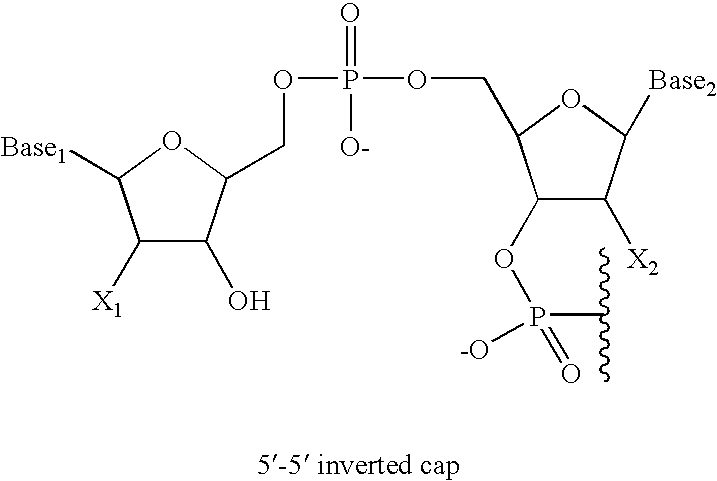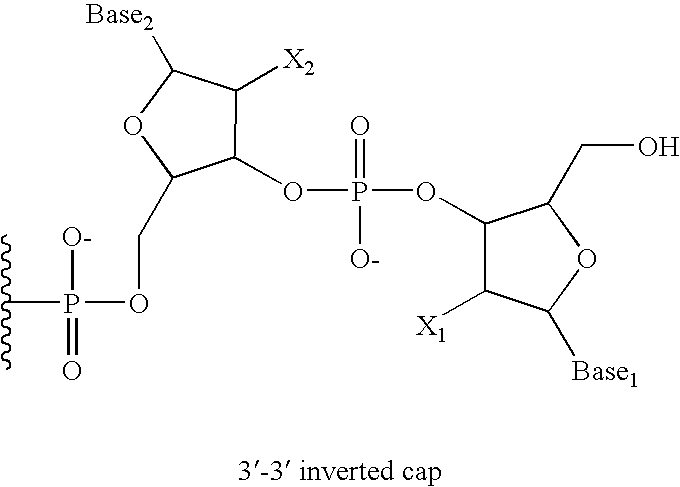5'-and 3'-capped aptamers and uses therefor
a technology of aptamers and caps, which is applied in the field of angiogenesis and neovascularization, can solve the problems of affecting the stability of aptamers, so as to improve the overall stability and reduce the susceptibility to exonucleases
- Summary
- Abstract
- Description
- Claims
- Application Information
AI Technical Summary
Benefits of technology
Problems solved by technology
Method used
Image
Examples
example 1
Synthesis of Anti-VEGF Aptamer
[0092] An oligonucleotide having 5′-5′ and 3′-3′ inverted nucleotide caps was synthesized at a 100 μmole scale on an Akta oligonucleotide synthesizer (Pharmacia) using the standard RNA synthesis template. The support material used was CPG (approx. 700 μ pore size) loaded with an inverted T, which was attached to the support via the 5′ hydroxyl of the thymidine. This support was purchased from Prime Synthesis.
[0093] Oligonucleotide 1, shown below, was prepared.
dT5′-5′CfGmGmArArUfCfAmGmUfGmAmAmUfGm(SEQ ID NO:1)CfUfUfAmUfAmCfAmUfCfCfGm3′-3′dT
[0094] In Oligonucleotide 1, Gm represents 2′-methoxyguanylic acid; Am represents 2′-methoxyadenylic acid; Cf represents 2′-fluorocytidylic acid; Uf represents 2′-fluorouridylic acid; Ar, represents riboadenylic acid; and dT represents deoxyribothymidylic acid. The oligonucleotide was synthesized using between 2 and 4 equivalents of phosphoramidites (2′ fluoro U, 2′ fluoro C (acetyl), 2′methoxy A ...
example 2
IC50 Testing for Anti-VEGF Aptamer
[0096] The ability of anti-VEGF aptamers to bind to human vascular endothelial growth factor (VEGF) was determined using a competitive binding ELISA-like assay. In this assay, recombinant VEGF165 is bound to the wells of a 96-well plate (Quadra 96 Plus). Following blocking of nonspecific reactive sites on the plate, a matrix of the test aptamer and a biotinylated competitor, the DNA oligonucleotide shown below, were added.
5′-XXCCCGTCTTCCAGACAAGAGTGCAGGG-3′(SEQ ID NO:1)
[0097]“X” represent a biotin moiety in the above representation. Both the biotinylated competitor and the test aptamer compete for binding sites on the immobilized VEGF. Following the removal of the unbound biotinylated competitor and unbound test aptamer, the amount of biotinylated competitor remaining is detected using a chemiluminescence reaction. The entire plate was immediately read on a luminometer (Victor 2). The amount of bound biotinylated competitor is inversely related to...
example 3
Stability of Anti-VEGF Aptamer
[0098] The stability of the 5′-5′- and 3′-3′-capped anti-VEGF aptamers to exonuclease digestion in a range of biological fluids is assessed, e.g., in fetal calf serum, in human serum, in human plasma, and in human synovial fluid. Convenient in vitro assays for measuring oligonucleotide stability against in vivo (physiological) nuclease degradation are known in the art and described in the literature (see, e.g., Biegelman et al. (1995) J. Biol. Chem. 270: 25702-8; Uhlmann et al. (1997) Antisense Nucleic Acid Drug Dev. 7: 345-50; and Pieken et al. (1991) Science 253: 314-7).
[0099] Briefly, the aptamer oligonucleotide to be analyzed is first labeled using methods known in the art, e.g., by 5′-end-labeling (at the 3′-3′ cap's free 5′ end) with T4 polynucleotide kinase and [γ-32P]ATP. For internal labeling, the capped anti-VEGF aptamers are first synthesized in two halves, and the 3′-half-aptamer portion is 5′-end-labeled using T4 polynucleotide kinase and...
PUM
| Property | Measurement | Unit |
|---|---|---|
| Fraction | aaaaa | aaaaa |
| Fraction | aaaaa | aaaaa |
| Fraction | aaaaa | aaaaa |
Abstract
Description
Claims
Application Information
 Login to View More
Login to View More - R&D
- Intellectual Property
- Life Sciences
- Materials
- Tech Scout
- Unparalleled Data Quality
- Higher Quality Content
- 60% Fewer Hallucinations
Browse by: Latest US Patents, China's latest patents, Technical Efficacy Thesaurus, Application Domain, Technology Topic, Popular Technical Reports.
© 2025 PatSnap. All rights reserved.Legal|Privacy policy|Modern Slavery Act Transparency Statement|Sitemap|About US| Contact US: help@patsnap.com



